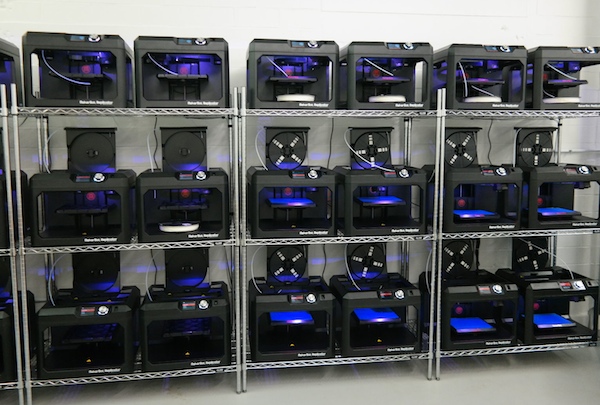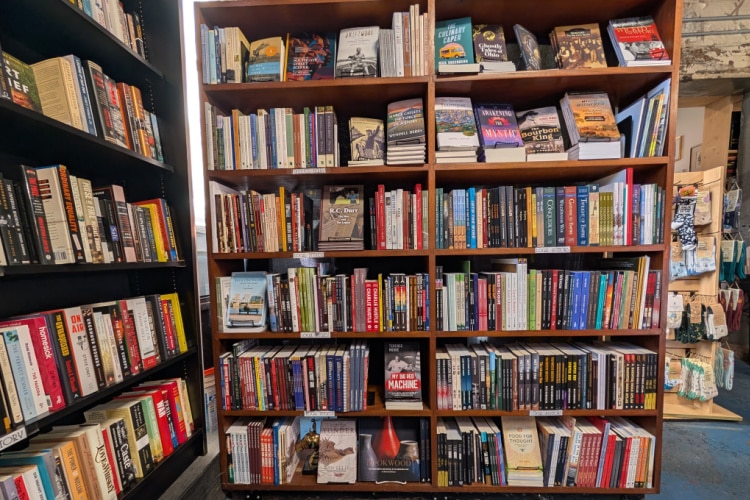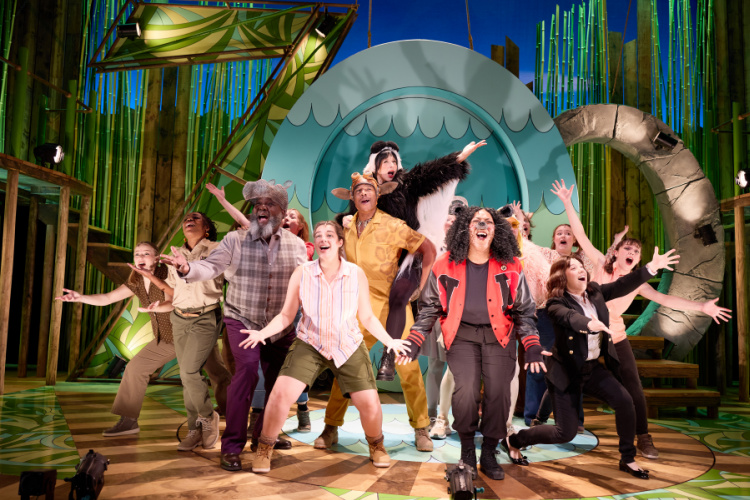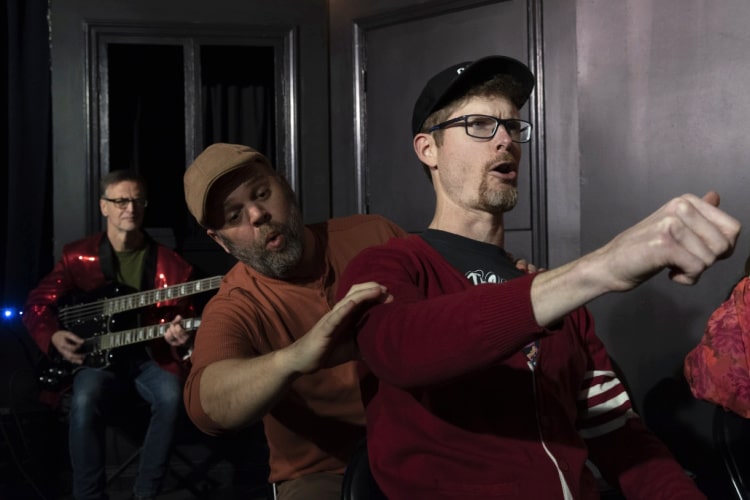Xavier University makes history with purchase of MakerBot 3D printing center
Xavier becomes the first private U.S. university to house a full MakerBot Innovation Center for 3D printing, seeing the move as a "game-changer" in how the school promotes innovation across majors and connects with local entrepreneurs.
Xavier University senior Alex Milliken spent the first two days of her “Intro to Human-Centered Making” class building a whiteboard with her classmates.
Why? Because Xavier’s new Center for Innovation didn’t have whiteboards yet.
Milliken, a computer science major, enrolled in the debut offering of Human-Centered Making — a course focused on designing and creating to enhance the human experience — due to her passion for design and interest in improving user interfaces. The class holds its sessions in the brand new Center for Innovation building at Dana and Woodward avenues and promises to bring digitally-created designs to life with the help of a useful tool called a 3D printer.
“Personally I love the idea of designing something and then printing it,” Milliken says. “You get to see this little machine create what you choose to build right in front off your eyes, which I think is amazing.”
What Milliken and her classmates don’t know is that Xavier is now home to 31 3D printers — more than any other private institution in the country. Xavier is just the fourth U.S. university and first private university to feature a full-service MakerBot 3D printing Innovation Center adjacent to the classrooms hoping to use it.
3D printing involves the use of filaments to create a three-dimensional model of a digital image. Most filaments are made of Polyactic Acid (PLA), a plastic-like material, but recent strides in the 3D printing field have brought options like wood, metal and ceramic to the table. With the right filaments, a person could literally print a structurally sound hammer.
Needless to say, the team behind the new 3D printing center is abuzz with excitement.
The idea
Xavier’s journey to its record-breaking status began over a year ago. Provost and Chief Academic Officer Scott Chadwick sent 36 members of his staff to an Innovation Engineering workshop at Eureka! Ranch last year. The workshop, located just east of Cincinnati, offers up a black belt certification in innovation through a grueling five-day course in which students are taught to think creatively and apply an innovation-geared mindset to any problem that confronts them.
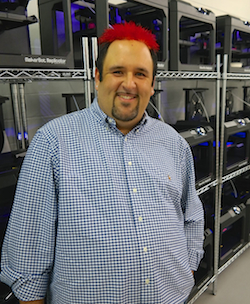
In attendance at this workshop were Shawn Nason, director of Xavier’s new Center for Innovation; Annette Marksberry, Assistant Provost and CIO for the university; Tom Merrill, founder of the new School for Arts and Innovation at Xavier; and Gary Lewondowski, a Xavier professor of mathematics and computer science; along with others. It was there that the idea for the Center for Innovation was born.
Several months later, during the week of Jan. 5, the now-certified innovators traveled to Las Vegas for the largest Consumer Electronics Show in the world. The Xavier group — consisting of Nason, Marksberry and Carol Maegly, vice president of budgeting for the Provost Area — found themselves attracted to the large section of the show dedicated to 3D printing. Within that section, the team approached the MakerBot booth.
MakerBot is a New York-based company specializing in 3D printing solutions. The MakerBot Innovation Center is a centralized 3D printing solution that includes software, hardware, services and support for organizations wishing to print on a large scale.
Florida Polytechnic University was one of the first academic institutions to install a MakerBot Innovation Center and is already making national news with their progress. Intrigued, the Xavier team wanted to learn more.
“We started chatting with the MakerBot Innovation Center rep,” Marksberry says, “talking about how cool it is, this totally customized 3D printing and scanning system.”
When the team showed increased interest, they were given a demo later that night. The Xavier folks could hardly contain their excitement.
“We were just abuzz with it,” Marksberry says. “It lit all three of us on fire. We couldn’t help but think, ‘Wow, what a world this would open for our students!'”
Within 24 hours, a decision had been made: A MakerBot Innovation Center was coming to Xavier’s own Center for Innovation.
Working with MakerBot involves no contract or long-term commitment; rather, it’s simply a purchase. Backed by private donors, Xavier’s purchase set the school up for the delivery of 31 printers, three scanners and a MakerBot Innovation Center Management Platform with software equipped to handle the entire system.
The printers themselves arrived at Xavier last week.
The bigger picture
Innovation at Xavier is hardly new. The new MakerBot Center will fit in nicely at the rapidly developing Center for Innovation that opened several weeks ago. With a newly established School for Arts and Innovation and a staff committed to forward-looking progress, 3D printing just seems like the next logical step.
Before MakerBot’s large-scale system was on their radar, Xavier had already housed three 3D printers. Lewondowksi had a 3D printer in his office in early 2013. As a member of the Digital Humanities Faculty Learning Committee, he found himself with funds to bring 3D printing to campus.
Within the next few months, Xavier librarian Alison Morgan applied for a grant to create a “maker space” within the main library. When she received the grant, two more printers were delivered. Expansion of the small existing center to one that’s 31 printers strong means that the opportunities for university and student involvement are endless.
“Given the speed (of the printers), you’re not going to get the kind of turnaround time you want when an entire class is using them,” Lewondowski says. “Plus eventually they can become a resource for the community, for companies looking to develop prototypes of their product, stuff like that.”
Nason also sees an incredible amount of potential for the fleet of printers.
“For us, this is about creating jobs that we don’t even know exist today,” he says. “This is an integral part of the whole Cincinnati startup community. This is not just about Xavier.”
From an academic standpoint, the new MakerBot Innovation Center offers opportunities for exploration among multiple disciplines. 3D printing has already been used in the healthcare space, helping to create everything from medical equipment to prosthetic limbs. Students on the business and management path can also use the printers to create prototypes of their product.
“You can print something in one piece instead of tiny, separate parts,” Merrill says.
Professors like Lewondowski also see potential in the humanities.
“Think about something like an item from history, an old button, let’s say,” he says. “It’s one thing to talk about it, but to hold something in your hand — that’s very different.”
Perhaps more than any other area, the Human-Centered Making major, introduced just this year, will undoubtedly bring students into the MakerBot center. The curriculum, designed by Lewondowski, is centered around designing products for humans. These products include anything from a 3D printed tool or item to a mobile application — anything that makes life easier for the user.
Lewondowski’s planned curriculum for the major (which is still in its early stages of development) will include everything from design thinking to community involvement through Crayons to Computers. He also hopes to add a liberal arts element to the major by requiring a Philosophy of Technology course.
“Xavier puts a strong emphasis on liberal arts training,” Lewondowski says, adding that he sees a tremendous benefit to discussing technology and how it relates to who we are as people.
With quite a few computer science majors in his class this semester, Lewondowski hopes to recruit more majors from the art department to his classes. Those who are used to working with a digital medium are likely to be intrigued by the ability to create a physical object.
“When you’re used to building virtual things, its great to see it live and in person,” he says.
Addressing concerns
Among the buzz and excitement, there is also some opposition to the new MakerBot purchase.
“People want to know if this is just a new toy or if it is really going to stick,” Nason says. “And I can totally understand that.”
“They’re worried about resources, whether this is really going to pay for itself,” Lewondowski adds. “But that’s a concern when you do anything.”
Alongside the skepticism comes strong support from Xavier’s Board of Trustees, their Senior Leadership Team and many others.
“They see this as a game-changer,” Nason says. “NKU has informatics, UC has DAAP, this can be Xavier’s footprint.”
Nason and his team also feel strong support from external sources. Players in the startup ecosystem like Cintrifuse have already voiced their support and excitement.
“We are deeply involved with Xavier and their efforts regarding entrepreneurship,” says Jordan Vogel, director of the entrepreneurial ecosystem at Cintrifuse. “There are all sorts of ways that we can be involved.”
When it comes to the MakerBot Innovation Center, Vogel says that while the university’s new addition is still news to them Cintrifuse can continue to contribute to the innovation-minded culture that will accompany the center’s arrival.
Specifically, Cintrifuse can act as a liaison between Xavier and the startups the university might want to patronize.
Cintrifuse is currently affiliated with two startups, Simplify3D and 3DLT, who can help bring a client base to the MakerBot Center. For instance, 3DLT works with retail clients to connect them with designers, consumers and the 3D printers themselves. Theoretically, Xavier could become one of those printers.
Beyond Xavier’s campus
The last day of Alex Milliken’s first week in Human-Centered Making went far beyond whiteboard construction. That Friday, Lewondowski’s class took a trip to Crayons to Computers, the free store where teachers from nearly 600 area schools pick up school supplies and other learning enrichment items.
The organization depends on reduced-cost purchases from wholesalers as well as private donations, and those donations are not always your basic, run-of-the-mill pencils and binders.
“That’s where we come in,” Milliken says. “We have to think about things one can make from some of those miscellaneous objects.”
One student in Lewindowski’s class thought of combining random tubing they found with plastic cupcake-like trays to create a hydroponics contraption. Not exactly a 3D printing project, but it could be. After all, the students taking classes in the Center for Innovation still don’t know that the MakerBots are on campus.
It’s safe to assume that, once they do, the innovation buzz at Xavier will only grow louder.

